人教部编版八年级英语 比较级和最高级的用法 汇总
- 格式:docx
- 大小:19.24 KB
- 文档页数:3
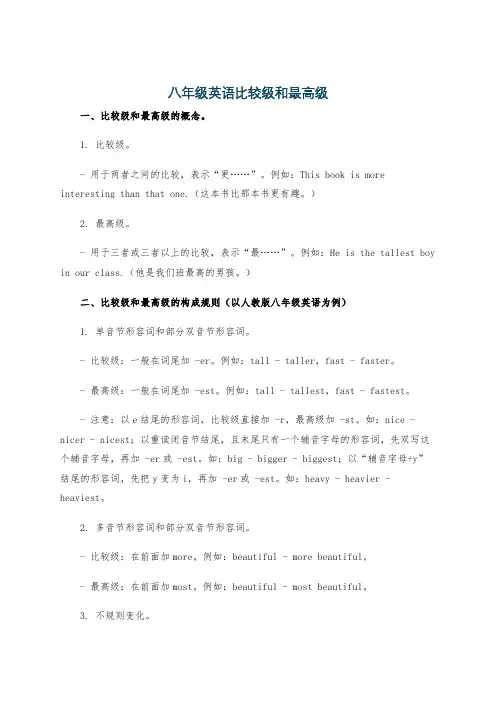
八年级英语比较级和最高级一、比较级和最高级的概念。
1. 比较级。
- 用于两者之间的比较,表示“更……”。
例如:This book is more interesting than that one.(这本书比那本书更有趣。
)2. 最高级。
- 用于三者或三者以上的比较,表示“最……”。
例如:He is the tallest boy in our class.(他是我们班最高的男孩。
)二、比较级和最高级的构成规则(以人教版八年级英语为例)1. 单音节形容词和部分双音节形容词。
- 比较级:一般在词尾加 -er。
例如:tall - taller,fast - faster。
- 最高级:一般在词尾加 -est。
例如:tall - tallest,fast - fastest。
- 注意:以e结尾的形容词,比较级直接加 -r,最高级加 -st。
如:nice - nicer - nicest;以重读闭音节结尾,且末尾只有一个辅音字母的形容词,先双写这个辅音字母,再加 -er或 -est。
如:big - bigger - biggest;以“辅音字母+y”结尾的形容词,先把y变为i,再加 -er或 -est。
如:heavy - heavier - heaviest。
2. 多音节形容词和部分双音节形容词。
- 比较级:在前面加more。
例如:beautiful - more beautiful。
- 最高级:在前面加most。
例如:beautiful - most beautiful。
3. 不规则变化。
- 一些形容词的比较级和最高级有不规则变化。
例如:- good/well - better - best.- bad/badly - worse - worst.- many/much - more - most.- little - less - least.- far - farther/further - farthest/furthest(farther表示距离上更远;further表示程度上更进一步)三、比较级和最高级的用法。
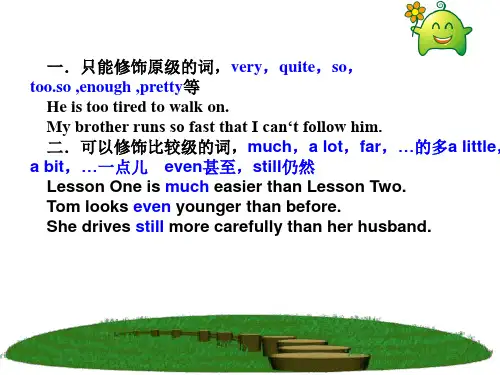
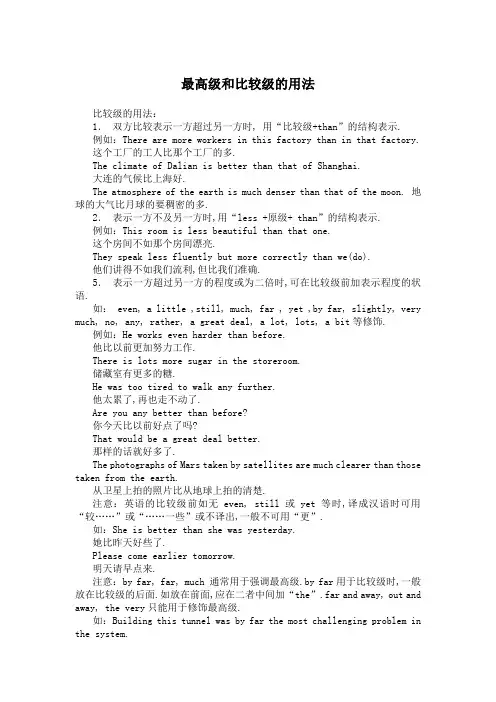
最高级和比较级的用法比较级的用法:1.双方比较表示一方超过另一方时, 用“比较级+than”的结构表示.例如:There are more workers in this factory than in that factory.这个工厂的工人比那个工厂的多.The climate of Dalian is better than that of Shanghai.大连的气候比上海好.The atmosphere of the earth is much denser than that of the moon. 地球的大气比月球的要稠密的多.2.表示一方不及另一方时,用“less +原级+ than”的结构表示.例如:This room is less beautiful than that one.这个房间不如那个房间漂亮.They speak less fluently but more correctly than we(do).他们讲得不如我们流利,但比我们准确.5.表示一方超过另一方的程度或为二倍时,可在比较级前加表示程度的状语.如: even, a little ,still, much, far , yet ,by far, slightly, very much, no, any, rather, a great deal, a lot, lots, a bit等修饰.例如:He works even harder than before.他比以前更加努力工作.There is lots more sugar in the storeroom.储藏室有更多的糖.He was too tired to walk any further.他太累了,再也走不动了.Are you any better than before?你今天比以前好点了吗?That would be a great deal better.那样的话就好多了.The photographs of Mars taken by satellites are much clearer than those taken from the earth.从卫星上拍的照片比从地球上拍的清楚.注意:英语的比较级前如无even, still或yet等时,译成汉语时可用“较……”或“……一些”或不译出,一般不可用“更”.如:She is better than she was yesterday.她比昨天好些了.Please come earlier tomorrow.明天请早点来.注意:by far, far, much 通常用于强调最高级.by far用于比较级时,一般放在比较级的后面.如放在前面,应在二者中间加“the”.far and away, out and away, the very只能用于修饰最高级.如:Building this tunnel was by far the most challenging problem in the system.建筑这样一条隧道无疑是这个系统中最棘手的工程.This is much the best.这是最好的.It is far and away ( or out and away) the best.这是好的无以复加.This is the very best book that he ever wrote.这是他写过的书中最好的一本.8.表示主语随另一方的程度而变化时,用“the +比较级(主语+谓语), the +比较级(主语+谓语)”的结构.例如:The harder he works, the happier he feels.他越努力工作越感到幸福.The higher we went up the mountain, the colder it became. 越往山的高处爬越冷.The more they talked, the more encouraged they felt.他们越说越感到鼓舞.12.不与其它事物相比,表示本身程度的改变时, 用“比较级+比较级”的结构.例如:The weather is getting colder and colder.天气越来越冷.The girl becomes more and more beautiful.这个女孩长得越来越漂亮.The days become longer and longer.天变的越来越长.We are walking more and more slowly.我们走得越来越慢.6. 在inferior(劣于), superior(优于), junior(年幼的), senior(年长的), prior(前面的), posterior(后面的)等后面用to代替than.例如:He is superior to Mr. Wang in mathematics.在数学上他比王先生好.His work is inferior to mine.他的工作不如我的好.He is 2 years senior to me.他比我大两岁.The duty is prior to all others.这项任务比其他任务都重要.7.在比较从句中为了避免重复,我们通常用that (those),one (ones)代替前面出现的名词,that指物,one既可指人,也可指物.that可代替可数名词单数和不可数名词,而one只能代替可数名词.例如:The book on the table is more interesting than that on the desk.餐桌上的那本书比课桌上的那本书有趣.A box made of iron is stronger than one made of wood .铁箱子比木箱子结实.“ the + 形容词的比较级+ of ”例如:He is the taller of the two.他是两个人中较高的一个.She is the more beautiful of the two sisters.她是两姐妹中较美的一个.Of the two landscapes that you have shown me, this one is the more picturesque.你给我看的两处景色中,这一处更别致.8.表示倍数的比较级有如下几种句型:A. A is three (four,etc.)times the size (height,length,width,etc.)of B例如:The new building is four times the size(the height)of the old one.这座新楼是那座旧楼的四倍大(四倍高).(这座新楼比那座旧楼大三倍[高三倍])B. A is three (four, etc.)times as big (high, long, wide, etc.)as B.例如:Asia is four times as large as Europe亚洲是欧洲的四倍大.(亚洲比欧洲大三倍.)C. A is three(four, etc.)times bigger(higher, longer, wider, etc.)than B例如:Your school is three times bigger than ours.你们的学校比我们的学校大三倍.(你们的学校是我们学校的四倍大.)用times表示倍数,一般限于表示包括基数在内三倍或三倍以上的数.表示两倍可以用twice或double.四、最高级的用法1. 三者或三者以上相比,2. 表示最高程度时,3. 用“the + 最高级”的结构表示.这种句式一般常有表示比较范围的介词短语.例如:Zhang Hui is the tallest of the three.张辉是三个人中最高的.He works (the) hardest in his class.他是班级中最用功的学生.2. 最高级可被序数词以及much, by far, nearly, almost, by no means, not quite, not really, nothing like等词语所修饰.例如:This hat is by far/much/ nearly/ almost/not nearly/ by no means/ not quite/nothing like the biggest.这个帽子是最大的.How much is the most expensive computer ?那个价格最昂贵的计算机需要多少钱?3. 表示“最高程度”的形容词,如excellent, extreme, perfect等,没有最高级,也不能用比较级.4. 形容词最高级修饰作表语或介词宾语的名词、代词时被修饰的词往往省略.例如:He is the tallest (boy) in his class.他是班级中最高的男孩.5. 作状语的副词最高级前可以不加定冠词.例如:Of all the boys he came (the) earliest.在所有的男生中他来得最早.。
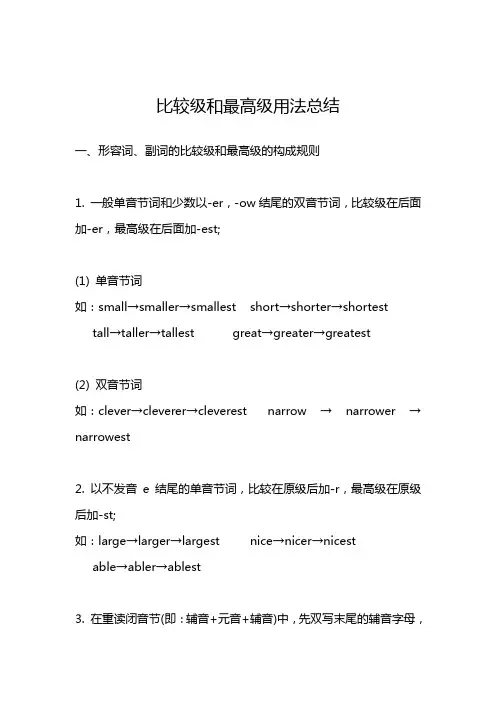
比较级和最高级用法总结一、形容词、副词的比较级和最高级的构成规则1. 一般单音节词和少数以-er,-ow结尾的双音节词,比较级在后面加-er,最高级在后面加-est;(1) 单音节词如:small→smaller→smallest short→shorter→shortest tall→taller→tallest great→greater→greatest(2) 双音节词如:clever→cleverer→cleverest narrow→narrower→narrowest2. 以不发音e结尾的单音节词,比较在原级后加-r,最高级在原级后加-st;如:large→larger→largest nice→nicer→nicest able→abler→ablest3. 在重读闭音节(即:辅音+元音+辅音)中,先双写末尾的辅音字母,比较级加-er,最高级加-est;如:big→bigger→biggest hot→hotter→hottest fat→fatter→fattest4. 以“辅音字母+y”结尾的双音节词,把y改为i,比较级加-er,最高级加-est;如:easy→easier→easiest heavy→heavier→heaviest busy→busier→busiest happy→happier→happiest5. 其他双音节词和多音节词,比较级在前面加more,最高级在前面加most;如:beautiful→more beautiful→most beautifuldifferent→more different→most differenteasily→more easily→most easily注意:①形容词最高级前通常必须用定冠词the,副词最高级前可不用。
例句:The Sahara is the biggest desert in the world.②形容词most前面没有the,不表示最高级的含义,只表示"非常"。

英语语法比较级和最高级用法知识点归纳总结一、比较级的用法1. 用于比较两个人或事物之间的差异或程度,常用结构为“as +原级+ as”或“not as/so +形容词/副词+ as”。
例如:- Mary is as tall as her sister.- This book is not as interesting as the one I read yesterday.2. 用于比较两种情况或行为的差异,常用结构为“比较级+ than”。
例如:- I prefer coffee to tea.- He runs faster than his friend.3. 用于表示“越来越……”的意思,常用结构为“比较级 + and + 比较级”。
例如:- The weather is getting colder and colder.- He is becoming more and more confident.4. 比较级的特殊形式:- 以字母e结尾的形容词,去掉e再加-er。
- 以重读闭音节结尾的单音节形容词和部分双音节形容词,直接加-er。
- 以“辅音字母+y”结尾的形容词,把y变成i再加-er。
例如:- nice → nicer- big → bigger- happy → happier二、最高级的用法1. 用于三个或三个以上人或事物之间的比较,表示最高程度,常用结构为“the + 最高级”。
例如:- She is the tallest girl in the class.- This is the most interesting book I've ever read.2. 最高级的特殊形式:- 以字母e结尾的形容词,去掉e再加-st。
- 以重读闭音节结尾的单音节形容词和部分双音节形容词,直接加-st。
- 以“辅音字母+y”结尾的形容词,把y变成i再加-est。
例如:- nice → nicest- big → biggest- happy → happiest三、比较级和最高级的不规则形式1. 比较级和最高级的不规则形式:good → better → best, bad → worse → worst, many/much → more → most, little → less→ least。
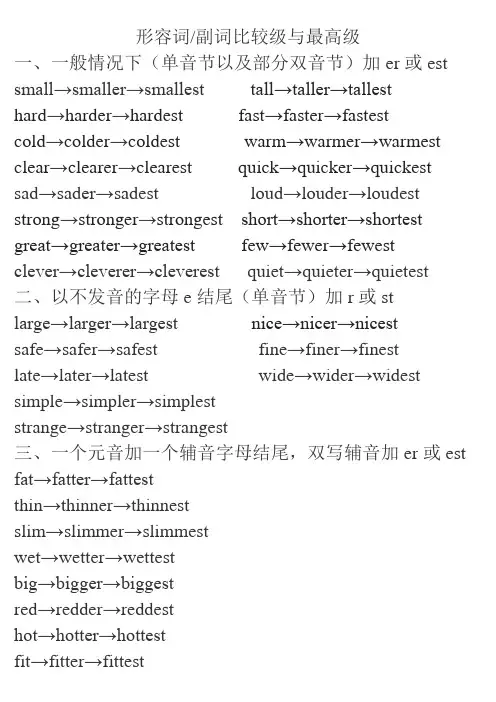
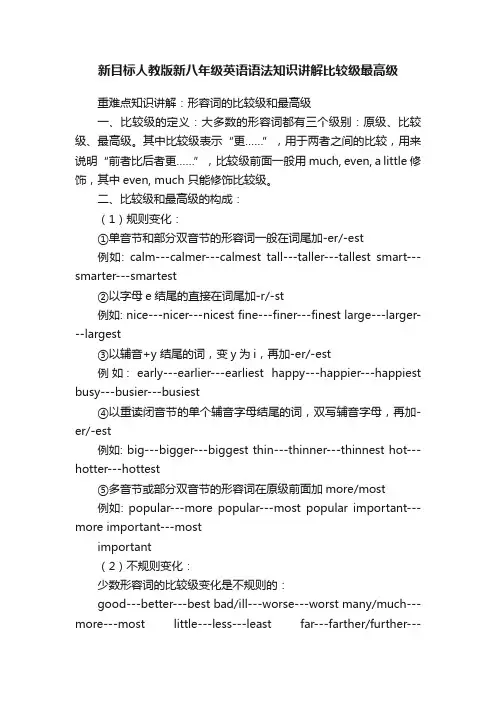
新目标人教版新八年级英语语法知识讲解比较级最高级重难点知识讲解:形容词的比较级和最高级一、比较级的定义:大多数的形容词都有三个级别:原级、比较级、最高级。
其中比较级表示“更……”,用于两者之间的比较,用来说明“前者比后者更……”,比较级前面一般用much, even, a little修饰,其中even, much 只能修饰比较级。
二、比较级和最高级的构成:(1)规则变化:①单音节和部分双音节的形容词一般在词尾加-er/-est例如: calm---calmer---calmest tall---taller---tallest smart---smarter---smartest②以字母e结尾的直接在词尾加-r/-st例如: nice---nicer---nicest fine---finer---finest large---larger---largest③以辅音+y 结尾的词,变y为i,再加-er/-est例如: early---earlier---earliest happy---happier---happiest busy---busier---busiest④以重读闭音节的单个辅音字母结尾的词,双写辅音字母,再加-er/-est例如: big---bigger---biggest thin---thinner---thinnest hot---hotter---hottest⑤多音节或部分双音节的形容词在原级前面加more/most例如: popular---more popular---most popular important---more important---mostimportant(2)不规则变化:少数形容词的比较级变化是不规则的:good---better---best bad/ill---worse---worst many/much---more---most little---less---least far---farther/further---farthest/furthestold---older/elder---oldest/eldest(注意)形容词前如加less 和least 则表示"较不"和"最不" ,如important 重要lessimportant 较不重要least important 最不重要三、比较级的用法:(一)当两个人或事物(A和B)进行比较时,我们需要用到形容词(副词)的原级或者比较级1.表达“A和B一样”,用as…as的结构。
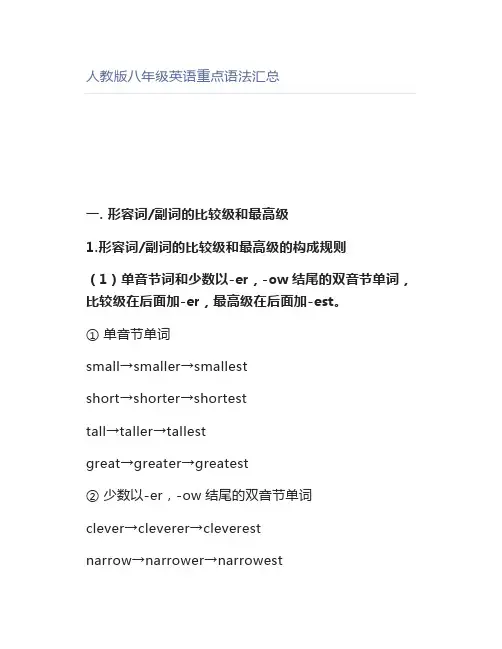
人教版八年级英语重点语法汇总一. 形容词/副词的比较级和最高级1.形容词/副词的比较级和最高级的构成规则(1)单音节词和少数以-er,-ow结尾的双音节单词,比较级在后面加-er,最高级在后面加-est。
① 单音节单词small→smaller→smallestshort→shorter→shortesttall→taller→tallestgreat→greater→greatest② 少数以-er,-ow结尾的双音节单词clever→cleverer→cleverestnarrow→narrower→narrowest(2)以不发音e结尾的单音节单词,比较级在原形后加-r,最高级在原级后加-st。
large→larger→largestnice→nicer→nicestable→abler→ablest(3)以一个辅音字母结尾的闭音节(即:辅音+元音+辅音)单词中,先双写末尾的辅音字母,比较级加-er,最高级加-est。
big→bigger→biggesthot→hotter→hottestfat→fatter→fattest(4)以“辅音字母+y”结尾的双音节词,把y改为i,比较级加-er,最高级加-est。
easy→easier→easiestheavy→heavier→heaviestbusy→busier→busiesthappy→happier→happiest(5)其他双音节词和多音节词,比较级在前面加more,最高级在前面加most。
beautiful→more beautiful→most beautifuldifferent→more different→most differenteasily→more easily→most easily(6)有少数形容词、副词的比较级和最高级是不规则的,必须熟记。
good→better→bestwell→better→bestbad→worse→worstill→worse→worstold→older/elder→oldest/eldestmany/much→more→mostlittle→less→leastfar →further/farther→ furthest/farthest2. 形容词和副词比较级的用法(1)“甲+be+(倍数)+形容词比较级+than+乙”表示“甲比乙…”或“甲比乙…几倍”。
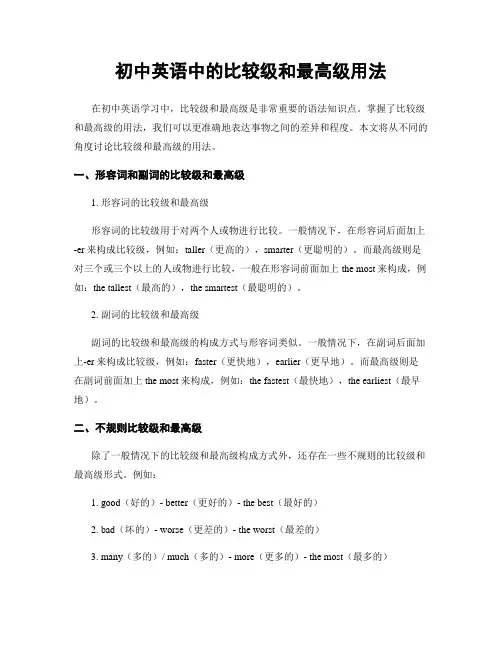
初中英语中的比较级和最高级用法在初中英语学习中,比较级和最高级是非常重要的语法知识点。
掌握了比较级和最高级的用法,我们可以更准确地表达事物之间的差异和程度。
本文将从不同的角度讨论比较级和最高级的用法。
一、形容词和副词的比较级和最高级1. 形容词的比较级和最高级形容词的比较级用于对两个人或物进行比较。
一般情况下,在形容词后面加上-er来构成比较级,例如:taller(更高的),smarter(更聪明的)。
而最高级则是对三个或三个以上的人或物进行比较,一般在形容词前面加上the most来构成,例如:the tallest(最高的),the smartest(最聪明的)。
2. 副词的比较级和最高级副词的比较级和最高级的构成方式与形容词类似。
一般情况下,在副词后面加上-er来构成比较级,例如:faster(更快地),earlier(更早地)。
而最高级则是在副词前面加上the most来构成,例如:the fastest(最快地),the earliest(最早地)。
二、不规则比较级和最高级除了一般情况下的比较级和最高级构成方式外,还存在一些不规则的比较级和最高级形式。
例如:1. good(好的)- better(更好的)- the best(最好的)2. bad(坏的)- worse(更差的)- the worst(最差的)3. many(多的)/ much(多的)- more(更多的)- the most(最多的)4. little(少的)- less(更少的)- the least(最少的)三、比较级和最高级的用法1. 比较级的用法比较级常用于对两个人或物进行比较,表示一个比另一个更高或更低的程度。
例如:My sister is taller than me.(我的姐姐比我高。
)在这个句子中,我们通过使用比较级的形式来表达姐姐比我更高这个事实。
2. 最高级的用法最高级用于对三个或三个以上的人或物进行比较,表示最高程度。
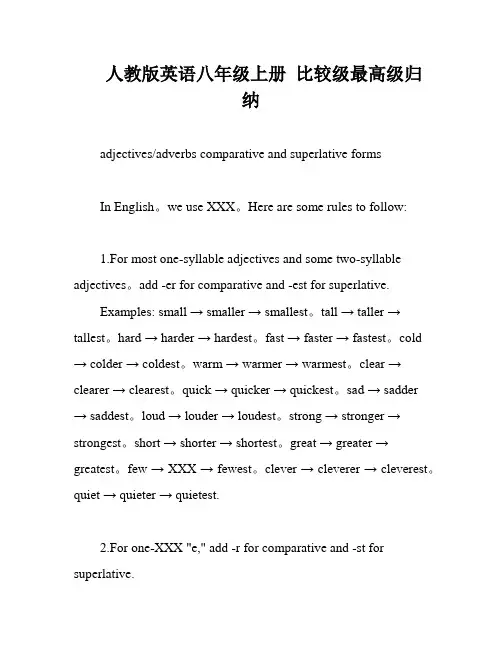
人教版英语八年级上册比较级最高级归纳adjectives/adverbs comparative and superlative formsIn English。
we use XXX。
Here are some rules to follow:1.For most one-syllable adjectives and some two-syllable adjectives。
add -er for comparative and -est for superlative.Examples: small → smaller → smallest。
tall → taller → tallest。
hard → harder → hardest。
fast → faster → fastest。
cold → colder → coldest。
warm → warmer → warmest。
clear → clearer → clearest。
quick → quicker → quickest。
sad → sadder→ saddest。
loud → louder → loudes t。
strong → stronger → strongest。
short → shorter → shortest。
great → greater → greatest。
few → XXX → fewest。
clever → cleverer → cleverest。
quiet → quieter → quietest.2.For one-XXX "e," add -r for comparative and -st for superlative.Examples: large → larger → largest。
nice → nicer → nicest。
safe → safer → safest。
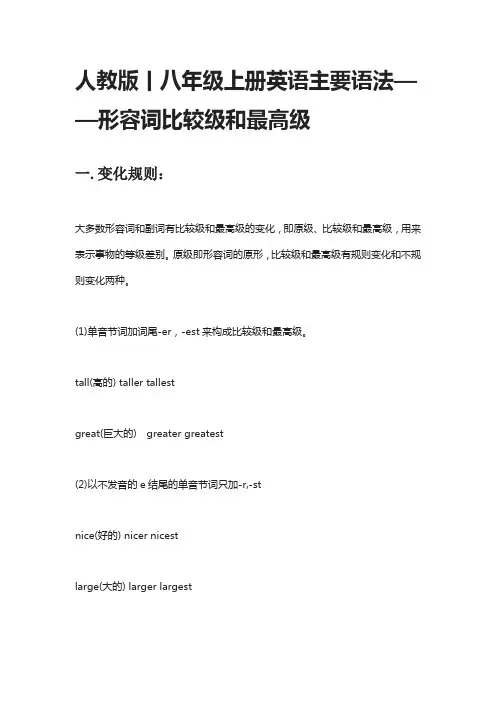
人教版丨八年级上册英语主要语法——形容词比较级和最高级一.变化规则:大多数形容词和副词有比较级和最高级的变化,即原级、比较级和最高级,用来表示事物的等级差别。
原级即形容词的原形,比较级和最高级有规则变化和不规则变化两种。
(1)单音节词加词尾-er,-est来构成比较级和最高级。
tall(高的) taller tallestgreat(巨大的) greater greatest(2)以不发音的e结尾的单音节词只加-r,-stnice(好的) nicer nicestlarge(大的) larger largestable(有能力的) abler ablest(3)以一个辅音字母结尾的闭音节单音节词,双写结尾的辅音字母,再加-er,-est big(大的) bigger biggesthot热的) hotter hottestred红色的redder reddest(4)"以辅音字母+y"结尾的双音节词,改y为i,再加-er,-esteasy(容易的) easier easiestbusy(忙的) busier busiest(5)以ly结尾的副词,除early-earlier-earliest,其他都是加more most. Slowly-more slowly-most slowlyBravely-more bravely-most bravelyquickly-more quickly-most quickly(6)少数以-er,-ow结尾的双音节词未尾加-er,-estclever(聪明的) cleverer cleverestnarrow(窄的) narrower narrowest(7)其他双音节词和多音节词在前面加more,most来构成比较级和最高级。
如:important(重要的) more important most importanteasily(容易地) more easily most easily(8)一些词的比较级和最高级,可以加-er或-est,也可以加more或most,如:clever, polite等。
八年级上形容词、副词的比较级和最高级的句型归纳一、形容词、副词的比较级用法1. 原级常用句型1)表示两者“相等”用“as+形容词原级+as+比较对象”This pen is as good as that one. 这支笔和那只笔一样好。
Your father is as kind as your mother. 你父亲和你母亲一样善良。
用“实意动词+as+副词原级+as+比较对象”Tom runs as fast as Mike. 汤姆和迈克跑得一样快。
2)表示“不如”或“不相等”用“not+as/so+形容词原级+as+比较对象”My pronunciation is not as/so good as yours. 我的发音不如你的。
用“助动词+not+as/so+副词原级+as+比较对象”He doesn't walk as slowly as you.他走路不像你那样慢。
3)表示“倍数”,如“一半/两倍/三倍/...”等用“half/twice/three times等倍数+as+形容词原级+as...”结构This room is four times as large as that one. 这个房间比那个房间大三倍。
Tom is twice as old as Kate. 汤姆的年龄是凯特的二倍。
用“实意动词+half/twice/three times等倍数+as+副词原级+as...”结构I study twice as hard as you. 我学习比你努力一倍。
Tom runs twice as fast as Mike. 汤姆跑得速度是迈克的二倍。
2. 形容词、副词比较级常用句型1)“甲+be+(倍数)+形容词比较级+than+乙”,表示“甲比乙…”或“甲比乙…几倍”Tom is taller than Kate. 汤姆比凯特高。
This room is three times bigger than that one. 这个房间比那个大三倍。
八年级英语比较级和最高级讲解与练习比较级和最高级一、比较级的用法:当两个人或事物(A和B)进行比较时,我们需要用到形容词(副词)的原级或者比较级1.表达“A和B一样”,用as…as的结构。
公式:A+be动词+as+形容词原级+as…+BA+实义动词+as+副词原级+as…+BEgI am as tall as you.He runs as fast as I.我的房间和她的一样大。
他游得和我一样好。
2.表达“A不如B”用not as…as的结构。
公式:A+be动词的否定形式+as+形容词原级+as…+BA+助词的否定形式+动词+as+形容词原级+as…+BEgI am not as tall as you.He doesn’t run as fast as I.我的房间没有他的大。
我没有他游得好。
3.表达“A大于B”用“比力级+than”的布局。
公式:A+be动词+形容词比较级+than+B…A+实义动词+副词比较级+than+B…EgI am taller than you.我比你高。
XXX faster than I.他跑得比我快。
我的房间比他的大。
我游得比他的好。
4.透露表现A是...中最大的布局公式:A+be动词+the +形容词最高级+范围A+实义动词+the+形容词最高级+范围I am XXX.XXX.我的房间是这里最大的。
我游得是我们班最好的。
二.形容词和副词的比较级和最高级的变化方法如下(1)吻合划定规矩的:情况一般情况以不发音e结尾的词以“子音+y”末端的词加法直接加-er ; -est去e加–er ; -est变y为i再加-er ; -est双写末尾辅音字母,再加-er ;重读闭音节末端的词-est在词前加more ; mostXXX-XXX-XXXmore deliciousmost delicious例词all-XXXXXXXXXheavy-heavier-heaviest多音节和局部双音节单词(2)几个不规则的形容词和副词的比较级和最高级如下表:原级good , wellbad , illmany , muchlittlefar练1:写出下列词的比较级和最高级tall﹍﹍﹍﹍slow﹍﹍﹍﹍small﹍﹍﹍﹍fast﹍﹍﹍﹍smart ﹍﹍﹍﹍few﹍﹍﹍﹍nice﹍﹍﹍﹍fine﹍﹍﹍﹍large﹍﹍﹍﹍late﹍﹍﹍﹍brave﹍﹍﹍﹍pretty﹍﹍﹍﹍easy﹍﹍﹍﹍funny﹍﹍﹍﹍happy﹍﹍﹍﹍lazy﹍﹍﹍﹍heavy﹍﹍﹍﹍dirty﹍﹍﹍﹍dry﹍﹍﹍﹍early﹍﹍﹍﹍比较级betterworsemorelessXXX最高级XXXworstmostleastXXX﹍﹍﹍﹍slim﹍﹍﹍﹍hot﹍﹍﹍﹍big﹍﹍﹍﹍thin﹍﹍﹍﹍fat﹍﹍﹍﹍wet﹍﹍﹍﹍beautiful﹍﹍﹍﹍﹍﹍﹍﹍interesting﹍﹍﹍﹍﹍﹍﹍﹍important﹍﹍﹍﹍﹍﹍﹍﹍dangerous﹍﹍﹍﹍﹍﹍﹍﹍expensive﹍﹍﹍﹍﹍﹍﹍﹍polite﹍﹍﹍﹍﹍﹍﹍﹍careful﹍﹍﹍﹍﹍﹍﹍﹍exciting﹍﹍﹍﹍bad/badly/ill﹍﹍﹍﹍little﹍﹍﹍﹍many/much﹍﹍﹍﹍old﹍﹍﹍﹍﹍﹍﹍﹍far﹍﹍﹍﹍﹍﹍﹍﹍练2填空1. Bob is_________ ( young ) than Fred but ___________(tall) than Fred.2. Yingtian is not as ___________(tall) as Yongxian.3. Almost all the students' faces are the same but Li Deming looks _______(fat) than before .4.Which is _________(heavy), a hen or a chicken?5. He is ______ (bad) at learning maths. He is much_______ (bad) at Chinese and he is the_________ (bad) at English.6. Annie says Sally is the ________ (kind) person in the world.7. An orange ia a little ______ (big) than an apple, but much ________ (small) XXX River is the_______ (long) river in China.9. Sue is a little ___________ (beautiful) than her sister.10.My room is not as_________(big) XXX' s.11.--How difficult is physics?--I' m not sure.--Is it ________(difficult) than maths?--I don' t think so.12.-- Annie plays the piano very ___________ (well).-- Sue plays it _____ (well) than Annie. And Sally plays it the _______(well).13. Saturdayis my_________ (busy) day in a week.操演3:挑选1. Which do you like _______, XXX coffee?A. XXX2.This work is _______ for me than for you.A. XXX difficult3.Who jumped_______of all?A. XXX4.Li Lei is_______ student in our class.A. XXX5. Tom is one of _______ boys in our class.A. XXX6. English is one of_______ XXX.A. XXXXXX7. Which is_______, Li Lei or Wu Tong?A. XXX..Jean works hard but she doesn’t work ____ Mary.A, XXX, as hard thanC, as harder asD, as hard as9.This is ____ book in our library.A, the most interestingB, most interestingC, the more interestingD, more interesting10.They got a Christmas tree and it was ____ ours.A, so tall asB, so taller asC, as tall asD, as taller as11.A taxi doesn’t run as ____ as an XXX.A, fastB, fasterC, fastestD, more fast12.Yangpu Bridge is one of ____ in the world.A, bigger bridgeB, the biggest bridgeC, the biggest bridgesD, bigger bridges13.Her cousin can draw ____ an artist.A, as well asB, not so well asC, as better asD, as good as14.Jinmao Tower is ____ building in Shanghai.A, highB, tallC, highestD, the tallest15. This box is___ that one.A. heavy thanB. so heavy thanC. heavier asD. as heavy as16 I think the story is not so ___ as that one.。
形容词/副词比较级与最高级一、一般情况下(单音节以及部分双音节)加er或est small→smaller→smallest tall→taller→tallesthard→harder→hardest fast→faster→fastest cold→colder→coldest warm→warmer→warmest clear→clearer→clearest quick→quicker→quickest sad→sad er→sadest loud→louder→loudest strong→stronger→strongest short→shorter→shortest great→greater→greatest few→fewer→fewest clever→cleverer→cleverest quiet→quieter→quietest 二、以不发音的字母e结尾(单音节)加r或st large→larger→largest nice→nicer→nicestsafe→safer→safest fine→finer→finest late→later→latest wide→wider→widest simple→simpler→simplest strange→stranger→strangest 三、一个元音加一个辅音字母结尾,双写辅音加er或est fat→fatter→fattest thin→thinner→thinnest slim→slimmer→slimmest wet→wetter→wettest big→bigger→biggest red→redder→reddest hot→hotter→hottestfit→fitter→fittest 四、辅音字母加y结尾,变y为i加er或est easy→easier→easiest angry→angrier→angriest busy→busier→busiest heavy→heavier→heaviest hungry→hungrier→hungriest crazy→crazier→craziest happy→happier→happiest early→earlier→earliest dirty→dirtier→dirtiest lucky→luckier→luckiestshy→shier→shiest funny→funnier→funniest lovely→lovelier→loveliest friendly→friendlier→friendliest 五、双音节以及多音节词前加more或most outgoing→more outgoing→most outgoing beautiful→more beautiful→most beautifuldifferent→more different→most differentquietly→more quietly→most quietly loudly→more loudly→most loudly slowly→more slowly→mo st slowly quickly→more quickly→mo st quickly sadly→more sadly→mo st sadly happily→more happily→mo st happily carefully→more carefully→mo st carefully serious→more serious→most serious →mo st similar similar→more similar→moeasily easily→more easily→most e asily clearly→more clearly→mo st clearly bored→more bored→mo st bored talented→more talented→mo st talented boring→more boring→mo st boring →mo st popular popular→more popular→moterrible→more terrible→mo st terrible delicious→more delicious→mo st delicious →mo st different different→more different→mo→mo st difficult difficult→more difficult→mo→mo st beautiful beautiful→more beautiful→moexpensive→more expensive→mo st expensive necessary→more necessary→mo st necessary →mo st important important→more important→mo→mo st wonderful wonderful→more wonderful→mocomfortable→more comfortable→mo st comfortable hardworking→more hardworking→mo st hardworking 不规则adj、adv比较级、最高级good/well→better→best bad/badly/ill→worse→worst many/much→more→most few/little→less→least old→older/elder→oldest/eldest far→farther/further→farthest/furthest 无比较级的adj/adv fantastic excellent favorite true(ly) false right wrong full empty round square possible impossible 。
形容词和副词的比较级和最高级(Comparative and Superlative Forms of Adjectives and Adverbs)大多数形容词和副词有三个等级:1.原级,即原形。
2.比较级,表示“较…”或“更…”3.最高级,表示“最…”2)不规则变化2.形容词和副词的比较级和最高级的用法比较级表示两者(人或事物)的比较。
在“比较级+than”的句型中,当than 前后所使用的动词相同时,通常用助动词代替后面的动词。
该助动词或者动词可以省略。
I'm more outgoing than my sister.You know more about yourself than I (do).He works much harder than me.最高级表示三者或三者以上(人或事物)的比较,其中有一个在某一方面超过其他几个,后面可用of(in) 短语等来说明比较的范围。
形容词最高级的前面一般要加定冠词the,最高级前的the 可以省去。
My cousin Li Jing is the funniest person I know.Screen City is the best theater in town.Who sings (the) most beautifully of the注意:在形容词和副词的比较级前,可以用much,a little 等修饰,如:much better, a little taller。
3. 表示两者在某一方面相同时,用“as+形容词或副词原形+as”的句型。
如:I think science is as important as math.Tom runs as fast as Jack,表示一方在某一方面不及另一方时,用“not as/so +形容词或副词原形+ as”的句型。
如:It is not as/ so warm today as yesterday.He did not come as/ so early as Wang Lin.I.写出下列形容词或副词的比较级1 hard2. fast3. late4. cute5.big6. hot7.early8.easy9.slowly10.clearlyII. 用方框中所给单词的适当形式填空funny, thin, hard-working, far, red, better11. Tina is heavier than Tara, so Tara is_______than Tina.12. This apple is much______than that one.13. Both of the two books are interesting, but I like this one_____.14. Jim jumps as_______as Tom.15.-Is Betty a good student?-Yes, she is not only smart but also16.-Who is_______ your mother or your father?-My father is. He always makes us laugh.。
比较级和最高级用法知识点总结比较级和最高级是英语中常用的语法结构,用于比较两个或多个事物之间的差异和程度。
在写作中正确运用比较级和最高级结构非常重要,本文将对比较级和最高级的用法进行总结。
一、比较级的用法:1. 形容词和副词的比较级形式:直接在形容词或副词后面加上-er,例如:bigger(更大的)、faster(更快的)。
以字母e结尾的形容词或副词,去掉e之后再加上-er,例如:nicer(更好的)、bigger(更大的)。
以辅音字母+y结尾的形容词,将y变为i,再加上-er,例如:funnier(更有趣的)。
部分形容词和副词变化不规则,例如:good - better(更好的)、bad - worse(更差的)。
2. 比较级的用法:用于比较两个事物或两种情况的差异,例如:He is taller than his brother.(他比他弟弟高。
)可以用于表示相同的道理适用于其他情况,例如:The earlier you arrive, the better seats you get.(你越早到,得到的座位越好。
)比较级常与than连用,表示与另一事物相比,例如:She is more beautiful than her sister.(她比她姐姐更漂亮。
)比较级前可以使用much、a little、a bit等词修饰,表示程度,例如:He is a little taller than me.(他比我稍微高一点。
)二、最高级的用法:1. 形容词和副词的最高级形式:直接在形容词或副词前面加上the,并在其后加上-est,例如:the biggest(最大的)、the fastest(最快的)。
以字母e结尾的形容词或副词,只需在其后加上-est,例如:the nicest(最好的)、the largest(最大的)。
以辅音字母+y结尾的形容词,将y变为i,再加上-est,例如:the funniest(最有趣的)。
人教版丨八年级英语上册全部语法一. 形容词/副词的比较级和最高级1. 形容词/副词的比较级和最高级的构成规则(1)单音节词和少数以-er,-ow结尾的双音节单词,比较级在后面加-er,最高级在后面加-est。
①单音节单词small→smaller→smallestshort→shorter→shortest tall→taller→tallestgreat→greater→greatest②少数以-er,-ow结尾的双音节单词clever→cleverer→cleverestnarrow→narrower→narrowest(2)以不发音e结尾的单音节单词,比较级在原形后加-r,最高级在原级后加-st。
large→larger→largestnice→nicer→nicestable→abler→ablest(3)以一个辅音字母结尾的闭音节(即:辅音+元音+辅音)单词中,先双写末尾的辅音字母,比较级加-er,最高级加-est。
big→bigger→biggesthot→hotter→hottestfat→fatter→fattest(4)以“辅音字母+y”结尾的双音节词,把y改为i,比较级加-er,最高级加-est。
easy→easier→easiestheavy→heavier→heaviest busy→busier→busiesthappy→happier→happiest(5)其他双音节词和多音节词,比较级在前面加more,最高级在前面加most。
beautiful→more beautiful→most beautifuldifferent→more different→most different easily→more easily→most easily(6)有少数形容词、副词的比较级和最高级是不规则的,必须熟记。
good→better→bestwell→better→bestbad→worse→worstill→worse→worstold→older/elder→oldest/eldest many/much→more→mostlittle→less→least far →further/farther→furthest/farthest2. 形容词和副词比较级的用法(1)“甲+be+(倍数)+形容词比较级+than+乙”表示“甲比乙…”或“甲比乙…几倍”。
比较:同级比较、比较级、最高级
(一)形容词和副词的比较级和最高级
形容词及副词的比较级和最高级变化形式
一、规则变化
1.一般在词尾直接加er或est,tall-taller-tallest,long-longer-longest
2.以不发音的字母e结尾的单词在词尾直接加r或st,nice-nicer-nicest
3.以辅音字母+y结尾的词,把y变为i,再加er或est,heavy-heavier-heaviest
4.重读闭音节,末尾只有一个辅音字母,双写这个辅音字母,再加er或est,big-bigger-biggest
【注】: 大,红,湿,热,悲,瘦,胖. 双写末辅再变级.(big/red/wet/hot/sad/thin/fat )
5.部分双音节词和多音节词分别在原级前加more构成比较级和most构成最高级,beautiful-more beautiful-most beautiful
【注】:表示否定意义(降级比较)在其前加less /least important----less important----least important
English is more interesting than Chinese =Chinese is less interesting than English . 6.由“形容词+ly”构成的副词,在其前加more/ most
slowly---more slowly----most slowly 类似的词:quickly / cheaply / clearly / quietly / loudly
但early—earlier---earliest
三、常见用法
*比较级考点:
1.形容词或副词的比较级+than。
如:You are taller than Tom. 你比Tom高。
可修饰比较级的词much even far still rather any a little a lot a bit
2.the+比较级,the+比较级。
越...越...
The harder you study,the better you will be。
The more carefully he writes,the less mistakes he makes。
3.比较级+ and+比较级/ more and more + 原级越来越...
Our motherland is becoming stronger and stronger.
Lucy becomes more and more outgoing .
4、the + 比+ of the two / twins 两者中/ 双胞胎中较......的
Lucy is the taller of the twins.
注:不要丢the
5、Which or Who + 谓语+ 比较级,A or B ?
Who runs faster, Lucy or Lily?
2. 最高级考点
说明:形容词的最高级前必须加the;副词的最高级前可省略the。
当最高级前有形容词性物主代词、指示代词、名词所有格修饰时不加the
It has the best service.
Bobs runs (the) fast.
My eldest daughter is 7 years old.
2. 最高级考点
①范围问题in / of ...
e.g. Tom is the tallest student in the class.
Spring is the best season of the year.
②“......之一”问题
e.g. Beijing is one of the biggest cities in the world.
③“the + 序数词+ 最高级+ n单”
e.g. the second longest river 第二长河
(4)比较级形式表示最高级含义
比+ than + any other + n单
比+ than + the other + n复
Mark works hardest in his class.
= Mark works harder than any other student in his class. = Mark works harder than the other students in his class.
3.同级比较(表示前后两者的情况一样)考点
①as + adj./adv.原级+ as 和......一样
e.g. She is as thin as Lily.
He writes as carefully as Linda.
②not + as/so + adj./adv.原级+ as 不如
e.g. Tony didn’t run so fast as Carter.。